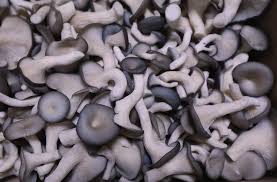Mushrooms have long been appreciated for their unique flavors, textures, and health benefits. Blue Oyster Mushrooms, in particular, have gained popularity in recent years for their distinctive appearance and taste. But where are Blue Oyster mushrooms typically found or grown? In this article, we will explore the natural habitat of Blue Oyster mushrooms and the methods used to cultivate them, both at home and on a commercial scale. We will also delve into their culinary uses and nutritional benefits, shedding light on why they have become such a sought-after ingredient.
2. Blue Oyster Mushrooms: An Overview
Blue Oyster mushrooms (Pleurotus ostreatus) are a species of edible fungi known for their unique blue-gray hue and delicious, nutty flavor. They are part of the Pleurotus genus, which includes other popular varieties like the White Oyster and King Oyster mushrooms. Blue Oyster mushroom are a versatile choice in the culinary world, often used in various dishes, including stir-fries, soups, and salads.
3. Natural Habitat of Blue Oyster Mushrooms
Blue Oyster mushrooms are not native to any specific region. Instead, they are opportunistic fungi that can be found growing in a wide range of environments. They typically thrive in temperate and subtropical climates, and their natural habitat can include the following locations:
- Deciduous forests: Blue Oyster mushrooms often grow on dead or decaying hardwood trees, particularly oak, maple, beech, and elm.
- Fallen logs and branches: These mushrooms can be found colonizing dead wood on the forest floor, making them a vital part of the decomposition process in ecosystems.
- Forest edges and clearings: Blue Oyster mushrooms sometimes make their appearance in areas with more light, such as the edges of forests or clearings.
- Urban settings: Blue Oyster mushrooms are adaptable and can even grow on hardwood logs and wood chips in urban environments, making them suitable for cultivation in small spaces.
While Blue Oyster mushrooms are capable of growing in various natural settings, they are also a popular choice for cultivation due to their adaptability and ease of growth.
4. Growing Blue Oyster Mushrooms at Home
One of the fascinating aspects of Blue Oyster mushrooms is that they can be cultivated at home with relative ease. Whether you are a seasoned mushroom enthusiast or a beginner, there are methods to suit various preferences and available space.
4.1. Indoor Cultivation
Indoor cultivation of Blue Oyster mushrooms involves using spawn (mycelium) on a suitable substrate. Common substrates include straw, sawdust, coffee grounds, or even cardboard. Here are the basic steps for indoor cultivation:
- Inoculation: Mix the Blue Oyster mushroom spawn with your chosen substrate and place it in a container or bag. Seal it to create a suitable environment for mycelium growth.
- Incubation: Allow the mycelium to colonize the substrate by keeping it at a specific temperature and humidity level, typically around 75-80°F (24-27°C) and 90-95% humidity.
- Fruiting: Once the mycelium has fully colonized the substrate, provide the right conditions for fruiting, which includes lower temperatures (around 55-60°F or 13-16°C), increased fresh air, and higher humidity.
- Harvesting: Blue Oyster mushrooms will develop and can be harvested within a few weeks once the fruiting conditions are met.
4.2. Outdoor Cultivation
Outdoor cultivation of Blue Oyster mushrooms is also possible if you have access to a suitable environment. Follow these steps for outdoor cultivation:
- Select a suitable outdoor location, preferably a shady area with good air circulation.
- Create a raised bed or mound of hardwood logs, wood chips, or straw, and inoculate it with Blue Oyster mushroom spawn.
- Keep the substrate moist and provide occasional shade, especially during hot and dry weather.
- After a few months, Blue Oyster mushrooms will begin to fruit, and you can harvest them as they mature.
5. Commercial Blue Oyster Mushroom Farming
Beyond home cultivation, Blue Oyster mushrooms are also commercially grown to meet the demand of the culinary market. Commercial cultivation follows specific methods and practices to ensure consistent production and quality.
5.1. Growing Methods
Commercial Blue Oyster mushroom farming often involves using climate-controlled environments, like greenhouses or grow rooms. Controlled conditions allow for year-round production and the ability to fine-tune factors such as temperature, humidity, and air quality. Substrates in commercial operations are carefully prepared and sterilized to minimize contamination and ensure optimal growth.
5.2. Harvesting and Storage
Commercial growers monitor their Blue Oyster mushroom crops closely to determine the ideal time for harvesting. Once harvested, mushrooms are typically packaged and shipped to various markets, including restaurants and grocery stores. Fresh Blue Oyster mushrooms have a relatively short shelf life, so proper storage and distribution are critical to maintain quality.
6. Culinary Uses and Nutritional Benefits
Blue Oyster mushrooms have gained popularity in the culinary world for their distinctive flavor and versatility. They offer a rich, nutty taste that complements a wide range of dishes, from pasta and stir-fries to soups and salads. These mushrooms have a unique texture that makes them an excellent meat substitute in vegetarian and vegan recipes.
In addition to their culinary appeal, Blue Oyster mushrooms are a healthy addition to your diet. They are a good source of vitamins, minerals, and antioxidants, such as vitamin D, B vitamins, selenium, and ergothioneine. These nutrients have been associated with various health benefits, including immune system support, improved cognitive function, and cancer-fighting properties.
7. Conclusion
Blue Oyster mushrooms are a fascinating fungi species with a versatile nature that allows them to thrive in various natural habitats and to be cultivated both at home and on a commercial scale. Whether you are interested in foraging for them in the wild or growing them in your garden or kitchen, Blue Oyster mushrooms offer a unique culinary experience and a host of nutritional benefits. As the demand for exotic and healthful ingredients continues to grow, Blue Oyster mushrooms are likely to remain a favorite choice for chefs and home cooks alike.




